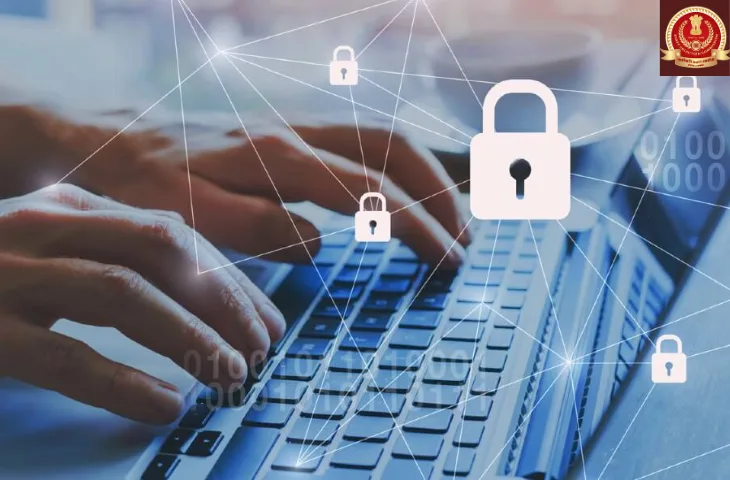Network and information security is an important topic in SSC CGL Tier 2 Computer Awareness. It focuses on protecting data, devices, and networks from unauthorized access or damage. Understanding common threats and preventive measures is crucial for exam preparation.
What is Network Security?
Network security involves policies, practices, and tools used to protect data and systems from cyber attacks, theft, or damage. It ensures confidentiality, integrity, and availability of information.
Common Network and Information Security Threats
In today’s digital world, protecting data and networks from cyber threats is essential. These threats can compromise system security, steal information, or disrupt network operations. The table below highlights the most common network and information security threats important for SSC CGL Tier 2 Computer Awareness:
| Threat Type | Description | Impact / Function |
| Hacking | Unauthorized access to a computer or network. | Hackers can steal data, install malware, or damage systems. |
| Virus | Malicious program that attaches to files and spreads when shared. | Can delete files, slow down systems, or corrupt data. |
| Worm | Self-replicating program that spreads automatically across networks. | Consumes network bandwidth and can crash systems. |
| Trojan | Malicious software disguised as a legitimate program. | Provides unauthorized access to hackers when executed. |
| Spyware | Secretly monitors user activities and sends data to attackers. | Steals personal or confidential information. |
| Phishing | Fraudulent attempt to steal sensitive information. | Done via fake emails or websites to capture passwords or financial data. |
| Denial of Service (DoS) Attack | Overloads a server or network with excessive requests. | Makes websites or services unavailable to users. |
Preventive Measures
To protect networks and information, the following measures are commonly used in SSC CGL Exam Tier 2 context:
- Antivirus and Anti-malware Software: Detects and removes viruses, worms, and Trojans.
- Firewalls: Blocks unauthorized access to networks.
- Strong Passwords: Using complex passwords and changing them regularly.
- Regular Updates: Keep software and systems up-to-date to patch vulnerabilities.
- Email and Web Security: Avoid clicking unknown links or downloading attachments from untrusted sources.
- Encryption: Protects data by converting it into unreadable formats for unauthorized users.
- Backup Data: Regular backups prevent loss in case of attacks.
- Network Monitoring: Constant monitoring helps detect unusual activity early.
Also check out: SSC CGL Typing Test Errors to minimize your errors in Data Entry Speed Test.
Key Takeaways:
Below are the key takeaways:
- Hacking, viruses, worms, and Trojans are frequently asked threats.
- Phishing and DoS attacks are also important.
- Knowing preventive measures is essential for answering scenario-based questions.
- Firewalls, antivirus, encryption, and backups are primary defense mechanisms.
- Awareness of current cyber security practices is useful for SSC CGL Computer Awareness.
FAQs
Ans. Network security refers to the protection of computer networks from unauthorized access, misuse, or attacks. It ensures data confidentiality, integrity, and availability.
Ans. The goal of information security is to protect information from unauthorized access, modification, or destruction while maintaining its confidentiality, integrity, and availability.
Ans. Common cyber threats include hacking, viruses, worms, Trojans, spyware, phishing, and DoS (Denial of Service) attacks.
Ans. A virus attaches to files and spreads when shared, while a worm spreads automatically across networks without any user action.
Ans. Phishing is a fraudulent attempt to steal sensitive information such as passwords or bank details through fake emails or websites.
- SSC CGL 2025 Tier 1 PYPs, Shift-Wise Previous Papers, Download PDFs
- SSC CGL Tier 2 Paper 1 Preparation Tips, Check now
- SSC CGL टॉप 5 हाई पेइंग जॉब्स कौन-सी हैं?, पूरी जानकारी यहां
- SSC CGL की तैयारी के लिए सबसे अच्छी किताबें कौन-सी हैं? यहां चेक करें
- SSC CGL पोस्ट प्रेफरेंस, SSC CGL की सबसे अच्छी पोस्ट क्या है?
- SSC CGL के लिए योग्यता क्या है? आयु सीमा, शिक्षा, शारीरिक मापदंड और अधिक

I’m Mahima Khurana, a writer with a strong passion for creating meaningful, learner-focused content especially in the field of competitive exam preparation. From authoring books and developing thousands of practice questions to crafting articles and study material, I specialize in transforming complex exam-related topics into clear, engaging, and accessible content. I have first hand experience of 5+ months in SSC Exams. Writing, for me, is not just a skill but a way to support and guide aspirants through their preparation journey one well-written explanation at a time.
